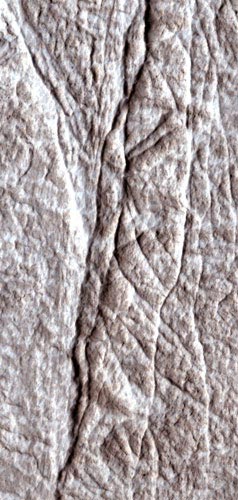Signs of Underground Plumbing Seen on Mars

A NASA probe has spotted hundreds of small surface fracturesnear Mars' equator that may have acted as underground natural plumbing tochannel groundwater billions of years ago.
Geologists compare the fractures in the sandstone rockdeposits on Mars to features called deformation bands on Earth, which can arisefrom the influence of groundwater in the underground bedrock. The bands andfaults have strong influences on groundwater movement on Earth, and seem tohave played the same role on Mars. Other research has examined how surfacewater fromrain or snow shaped the planet surface, but many agree that groundwater hasan equally important influence.
"Groundwater often flows along fractures such asthese, and knowing that these are deformation bands helps us understand how theunderground plumbing may have worked within these layered deposits," saidChris Okubo, a geologist with the U.S. Geological Survey in Flagstaff, Ariz.who headed up a new study of the Martian fractures.
The observations, made by NASA's Mars ReconnaissanceOrbiter (MRO), showed how water has already changed the color and texture ofthe Martian sandstone along the fractures. Okubo's report on the finding isdetailed online this month in the journal Geological Society of AmericaBulletin.
"This study provides a picture of not just surfacewater erosion, but true groundwater effects widely distributed over theplanet," said Suzanne Smrekar, deputy project scientist for MRO at NASA'sJet Propulsion Laboratory in Pasadena, Calif., who was not part of the study."Groundwater movement has important implications for how the temperatureand chemistry of the crust have changed over time, which in turn affects thepotential for habitatsfor past life."
Okubo and his study coauthors looked to similar patternsin Utah sandstones on Earth, where fractures are typically a few yards wide andup to several miles long. Such cracks reveal themselves as the rock layers ontop erode away.
MRO found similar fractures in a 43-mile-wide (70-km-wide)crater that sits just slightly north of the red planet's equator. Discovery ofthe deformation bands within the crater prompted scientists to name it afterCharles Capen, a late astronomer who worked at observatories in SouthernCalifornia and Flagstaff, Ariz.
Get the Space.com Newsletter
Breaking space news, the latest updates on rocket launches, skywatching events and more!
"These structures are important sites for futureexploration and investigations into the geologicalhistory of water and water-related processes on Mars," Okubo andco-authors stated in their study.
- Video - A Wet Modern Mars?
- Images - Visualizations of Mars
- Zoom In - Water on Mars?
Join our Space Forums to keep talking space on the latest missions, night sky and more! And if you have a news tip, correction or comment, let us know at: community@space.com.

Space.com is the premier source of space exploration, innovation and astronomy news, chronicling (and celebrating) humanity's ongoing expansion across the final frontier. Originally founded in 1999, Space.com is, and always has been, the passion of writers and editors who are space fans and also trained journalists. Our current news team consists of Editor-in-Chief Tariq Malik; Editor Hanneke Weitering, Senior Space Writer Mike Wall; Senior Writer Meghan Bartels; Senior Writer Chelsea Gohd, Senior Writer Tereza Pultarova and Staff Writer Alexander Cox, focusing on e-commerce. Senior Producer Steve Spaleta oversees our space videos, with Diana Whitcroft as our Social Media Editor.









